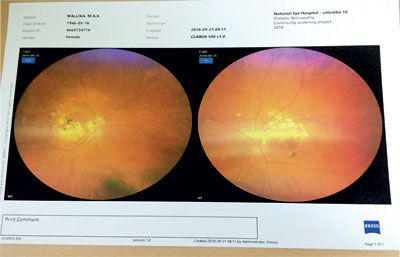News
Get your eyes tested for diabetic retinopathy with sophisticated retinal camera at the Eye Hospital
With the National Eye Hospital in Colombo getting temporary possession of a Non-Mydriatic Retinal Camera, an urgent request is going out to the public to walk in and get their eyes tested for diabetic retinopathy.

People can walk into Room 30 any time between 8 a.m. and 4 p.m. on any week day in the next four weeks, to get their eyes tested
There is no need for an appointment, no requirement of a prior booking, there are no queues and there will be no “waiting time” required as eye dilation is not needed, says Consultant Physician Dr. Waruna Gunathilaka based at the National Eye Hospital.
People can walk into Room 30 any time between 8 a.m. and 4 p.m. on any week day in the next four weeks, the Sunday Times learns.
Pointing out that the Non-Mydriatic Retinal Camera is not available in either the state or private sector in Sri Lanka, Dr. Gunathilaka explains that this sophisticated tool is very valuable in conducting mass screenings for diabetic retinopathy.
He says that usually the traditional method for the detection of diabetic retinopathy in primary care settings is to dilate the pupil and for an Eye Surgeon to look into the eye with an Ophthalmoscope.
However, with the sophisticated ultra-high definition, wide-angle Non-Mydriatic Retinal Camera which can be handled by nursing officers, no pupillary dilation is required. The camera takes a series of images, analyses them and stores them in a computer. These images can be studied by an Eye Surgeon later, says Dr. Gunathilaka, adding that this is ideal particularly in a setting where Eye Surgeons are scarce. There is no patient inconvenience and there is time saving.
With the latest data on the prevalence of diabetes indicating that there may be 6 out of 10 people hit by this non-communicable disease (NCD), he stresses the vital need for mass screening of people for diabetic retinopathy.
“Most people don’t understand the gravity of diabetic retinopathy. We control diabetes but generally don’t undergo screening for complications,” he says, explaining that the Non-Mydriatic Retinal Camera will collect all the information and store it in the computer, so that it can be analysed later by an Eye Surgeon. The nurses in charge of the camera will take down the contact details of those who get themselves screened and they will be informed later about what follow-up is needed.
It is understood that the Non-Mydriatic Retinal Camera, an ophthalmic instrument, captures high resolution colour and monochrome images of the retina and the anterior segment of the human eye.

